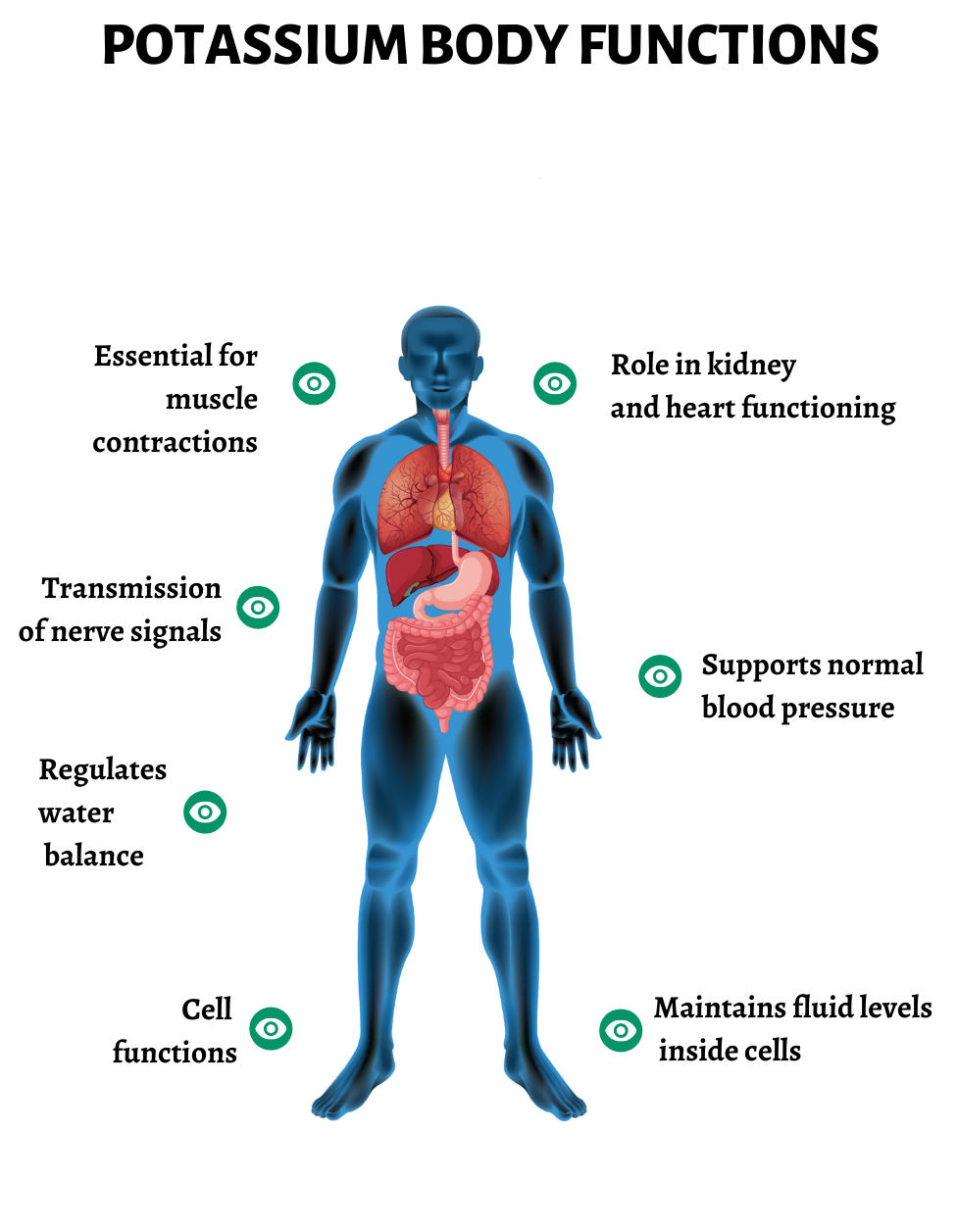
Potassium (K) is a micronutrient, which is a constituent of a larger family of electrolytes to include phosphorus (P), chloride (Cl), calcium (Ca), and sodium (Na) (Gropper, Smith, & Carr, 2018). When in balanced concentrations, electrolytes facilitate nerve conduction, movement of nutrients within a cell, pH balance, and fluid balance (Fluid and Electrolyte Balance, 2018). In this author’s last post, Mg was reviewed to include its influence upon muscle contraction. The following will consider K’s presence in foods, reasons behind deficiencies, and its affect upon muscle/blood pressure regulation.

K is a dominant electrolyte in which approximately 98% of said micronutrient is found intracellularly compromising about 130 g in mass from a 70 kg individual (Gropper et al., 2018). Such a micronutrient has a wide reach finding its presence in a variety of foods with a particular abundance among fruits and vegetables (i.e., leafy green vegetables, asparagus, mushrooms, avocados, bananas, nuts, and seeds (Gropper et al., 2018). K can also be found within multivitamins; however, its concentration is generally low (i.e., 100mg). Despite K’s presence in foods, North Americans tend to consume less than current recommendations of 4700 mg/day (Gropper et al., 2018. As such, the following will consider reasons behind said deficiency.

Gropper et al. (2018) indicated that deficiencies in K often arises from events (i.e., intense activity, sweating) whereby considerable losses of fluids and electrolytes occurs. Furthermore, K deficiency can also emanate from a lack of balance with other micronutrients to include Mg; such an imbalance facilitates K excretion via urination (Gropper et al., 2018). Additionally, certain medications can also participate in K losses such as glucocorticoids (decrease inflammation) and diuretics (can be used to treat high blood pressure) (Gropper et al., 2018). Finally, K deficiency can occur amongst individuals afflicted with gastrointestinal disorders such as inflammatory bowel disease (IBS). Having considered the nature of K deficiencies, the following will explore said micronutrient’s affects upon blood pressure.

Cardiovascular disease (CVD) is defined and characterized by the buildup of plaque, which increases the risk of blockages, cardiac tissue dysfunction, heart attack, stroke, and death (Jin, 2018). Risk factors associated with CVD include high cholesterol, family history of heart disease, diabetes, smoking, older age, overweight/obesity, and high blood pressure (Jin, 2018). Since the cardiac muscle operates is an electro-chemical fashion, it has by default, an inherent relationship with electrolytes (nerve conduction) to include K. As discussed, a delicate and precise interplay occurs between all electrolytes and their efforts to optimize nerve conduction. As such, K concentrations have a direct affect upon cardiac tissue contraction and hence, blood pressure. The following will explore the same.

As previously outlined, K has been linked to increased blood pressure/hypertension and CVD especially when higher dietary intake of sodium is occurring (Gropper et al., 2018). One of K’s mechanisms of blood pressure regulation is through its affects upon cardiac nerve conduction; resting membrane potential is regulated by the concentration and ratio of K inside and outside of the cell (Gropper et al., 2018). Thus, said micronutrient has direct affects upon depolarization and contractility of cardiac tissue. K also has affects upon blood pressure by influencing fluid levels in the body. Such is achieved by interaction with kidney physiology. The following will explore the same.

K interacts with Na which stimulates the kidneys to excrete fluids or hold fluids. Excess sodium is flushed out via increased kidney function. However, K is also lost. If such a process continues, the body will begin reducing excretion to maintain K levels which also increases water retention (increasing blood pressure) (Potassium and Sodium Out of Balance, 2018; Why Potassium Helps to Lower Blood Pressure, 2018). Another interaction with K consumption includes a condition known as hyperkalemia which is defined by excessive intakes of foods and supplements rich in potassium that exceeds adequate intakes (AI) of 4700 mg (Gropper et al., 2018). Such intakes have an inverse relationship with blood pressure; levels above AI tend to decrease blood pressure.
In conclusion, K is a micronutrient found amongst a larger family of electrolytes to include phosphorus (P), chloride (Cl), calcium (Ca), and sodium (Na) (Gropper et al., 2018). When in balanced concentrations, electrolytes facilitate nerve conduction, movement of nutrients within a cell, pH balance, and fluid balance (Fluid and Electrolyte Balance, 2018). However, as covered in previous sections, K tends to be under-consumed in the North American population leading to aberrations in its aforementioned functions, to include blood pressure regulation. Consumption of foods rich in K, coupled with awareness of signs and symptoms of K deficiency, should help individuals reach adequate levels in a manner that is both safe and efficacious.
References
Fluid and Electrolyte Balance (2018). Retrieved from https://medlineplus.gov/fluidandelectrolytebalance.html
Gropper, S. S., Smith, J. L., & Carr, T. P. (2018). Advanced nutrition and human metabolism (7thed.). Boston, MA: Cengage Learning.
Jin, J. (2018). Risk assessment for cardiovascular disease with non-traditional risk factors. The Journal of the American Medical Association, 320(3), 316.
Potassium and Sodium Out of Balance (2018). Retrieved from https://www.health.harvard.edu/newsletter_article/Potassium_and_sodium_out_of_balance
Why Potassium Helps to Lower Blood Pressure (2018). Retrieved from http://www.bloodpressureuk.org/microsites/salt/Home/Whypotassiumhelps
-Michael McIsaac
